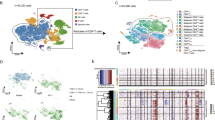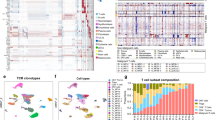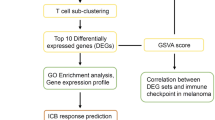Abstract
Sezary syndrome (SS) is a rare, aggressive CD4+ cutaneous T-cell lymphoma (CTCL); molecular traits differentiating SS from nonleukemic mycosis fungoides (MF) and from inflammatory skin diseases (ID) are not sufficiently characterized. Peripheral blood mononuclear cells (PBMC) of 10 SS patients and 10 healthy donors (HD) were screened by Affymetrix U133Plus2.0 chips for differential gene expression. Ten candidate genes were confirmed by qRT-PCR to be significantly overexpressed in CD4+ T cells of SS versus HD/ID. For easier clinical use, these genes were re-analyzed in PBMC; qRT-PCR confirmed five novel (DNM3, IGFL2, CDO1, NEDD4L, KLHDC5) and two known genes (PLS3, TNFSF11) to be significantly overexpressed in SS. Multiple logistic regression analysis revealed that CDO1 and DNM3 had the highest discriminative power in combination. Upon comparison of PBMC and skin samples of SS versus MF, CDO1 and DNM3 were found upregulated only in SS. Using anti-CDO1 antisera, differential expression of CDO1 protein was confirmed in SS CD4+ T cells. Interestingly, DNM3 and CDO1 are known to be regulated by SS-associated transcription factors TWIST1 and c-myb, respectively. Furthermore, CDO1 catalyzes taurine synthesis and taurine inhibits apoptosis and promotes chemoprotection. In summary, CDO1 and DNM3 may improve the diagnosis of SS and open novel clues to its pathogenesis.
This is a preview of subscription content, access via your institution
Access options
Subscribe to this journal
Receive 12 print issues and online access
$259.00 per year
only $21.58 per issue
Buy this article
- Purchase on Springer Link
- Instant access to full article PDF
Prices may be subject to local taxes which are calculated during checkout

Similar content being viewed by others

References
Dippel E, Goerdt S, Assaf C, Stein H, Orfanos CE . Cutaneous T-cell lymphoma severity index and T-cell gene rearrangement. Lancet 1997; 350: 1776–1777.
Klemke CD, Mannsmann U, Poenitz N, Dippel E, Goerdt S . Prognostic factors and prediction of prognosis by the CTCL Severity Index in mycosis fungoides and Sézary syndrome. Br J Dermatol 2005; 153: 118–124.
Dippel E, Assaf C, Hummel M, Schrag HJ, Stein H, Goerdt S et al. Clonal T-cell receptor gamma-chain gene rearrangement by PCR-based GeneScan analysis in advanced cutaneous T-cell lymphoma: A critical evaluation. J Pathol 1999; 188: 146–154.
Dippel E, Klemke D, Hummel M, Stein H, Goerdt S . T-cell clonality of undetermined significance. Blood 2001; 98: 247–248.
Klemke CD, Fritzsching B, Franz B, Kleinmann EV, Oberle N, Poenitz N et al. Paucity of FOXP3+ cells in skin and peripheral blood distinguishes Sezary syndrome from other cutaneous T-cell lymphomas. Leukemia 2006; 20: 1123–1129.
Poszepczynska-Guigne E, Schiavon V, D'Incan M, Echchakir H, Musette P, Ortonne N et al. CD158k/KIR3DL2 is a new phenotypic marker of Sezary cells: relevance for the diagnosis and follow-up of Sezary syndrome. J Invest Dermatol 2004; 122: 820–823.
Nebozhyn M, Loboda A, Kari L, Rook AH, Vonderheid EC, Lessin S et al. Quantitative PCR on 5 genes reliably identifies CTCL patients with 5–99% circulating tumor cells with 90% accuracy. Blood 2006; 107: 3189–3196.
Chu TM, Weir B, Wolfinger R . A systematic statistical linear modeling approach to oligonucleotide array experiments. Math Biosci 2002; 176: 35–51.
Allison PD . Logistic Regression Using SAS System: Theory and Application. SAS Institute Inc.: Cary, NC, 1999, Chapter 2 and 3:4–78.
Wald A . Tests of statistical hypotheses concerning several parameters when the number of observations is large. Trans Amer Math Soc 1943; 54: 426–482.
Kari L, Loboda A, Nebozhyn M, Rook AH, Vonderheid EC, Nichols C et al. Classification and prediction of survival in patients with the leukemic phase of cutaneous T cell lymphoma. J Exp Med 2003; 197: 1477–1488.
Su MW, Dorocicz I, Dragowska WH, Ho V, Li G, Voss N et al. Aberrant expression of T-plastin in Sezary cells. Cancer Res 2003; 63: 7122–7127.
Van Doorn R, Dijkman R, Vermeer MH, Out-Luiting JJ, van der Raaij-Helmer EM, Willemze R et al. Aberrant expression of the tyrosine kinase receptor EphA4 and the transcription factor twist in Sezary syndrome identified by gene expression analysis. Cancer Res 2004; 64: 5578–5586.
Hahtola S, Tuomela S, Elo L, Hakkinen T, Karenko L, Nedoszytko B et al. Th1 response and cytotoxicity genes are down-regulated in cutaneous T-cell lymphoma. Clin Cancer Res 2006; 12: 4812–4821.
Maher SG, Condron CE, Bouchier-Hayes DJ, Toomey DM . Taurine attenuates CD3/interleukin-2-induced T cell apoptosis in an in vitro model of activation-induced cell death (AICD). Clin Exp Immunol 2005; 139: 279–286.
Takatani T, Takahashi K, Uozumi Y, Shikata E, Yamamoto Y, Ito T et al. Taurine inhibits apoptosis by preventing formation of the Apaf-1/caspase-9 apoptosome. Am J Physiol Cell Physiol 2004; 287: C949–C953.
Ozgen U, Savasan S, Stout M, Buck S, Ravindranath Y . Further elucidation of mechanism of resistance to vincristine in myeloid cells: role of hypochlorous acid in degradation of vincristine by myeloperoxidase. Leukemia 2000; 14: 47–51.
Ramsden DB, Kapadi A, Fitch NJ, Farmer MJ, Bennett P, Williams AC . Human cysteine dioxygenase type I (CDO-I; EC 1.13.11.20): 5′ flanking region and intron-exon structure of the gene. Mol Pathol 1997; 50: 269–271.
Poenitz N, Simon-Ackermann J, Gratchev A, Qadoumi M, Klemke CD, Stadler R et al. Overexpression of c-myb in leukaemic and non-leukaemic variants of cutaneous T-cell lymphoma. Dermatology 2005; 211: 84–92.
Loebel DA, Tsoi B, Wong N, Tam PP . A conserved noncoding intronic transcript at the mouse Dnm3 locus. Genomics 2005; 85: 782–789.
Li CM, Margolin AA, Salas M, Memeo L, Mansukhani M, Hibshoosh H et al. PEG10 is a c-MYC target gene in cancer cells. Cancer Res 2006; 66: 665–672.
Lin CS, Lau A, Huynh T, Lue TF . Differential regulation of human T-plastin gene in leukocytes and non-leukocytes: identification of the promoter, enhancer, and CpG island. DNA Cell Biol 1999; 18: 27–37.
Aliahmad P, O'Flaherty E, Han P, Goularte OD, Wilkinson B, Satake M et al. TOX provides a link between calcineurin activation and CD8 lineage commitment. J Exp Med 2004; 199: 1089–1099.
Acknowledgements
We thank Dr M Goebeler for critically reading the manuscript and Dr K Schledzewski, Mrs Arif-Said, Mrs Schmuttermaier and Mrs Demory for excellent technical assistance.
Author information
Authors and Affiliations
Corresponding author
Additional information
Supplementary Information accompanies the paper on the Leukemia website (http://www.nature.com/leu)
Rights and permissions
About this article
Cite this article
Booken, N., Gratchev, A., Utikal, J. et al. Sézary syndrome is a unique cutaneous T-cell lymphoma as identified by an expanded gene signature including diagnostic marker molecules CDO1 and DNM3. Leukemia 22, 393–399 (2008). https://doi.org/10.1038/sj.leu.2405044
Received:
Revised:
Accepted:
Published:
Issue Date:
DOI: https://doi.org/10.1038/sj.leu.2405044
Keywords
This article is cited by
-
The role of NEDD4 related HECT-type E3 ubiquitin ligases in defective autophagy in cancer cells: molecular mechanisms and therapeutic perspectives
Molecular Medicine (2023)
-
Single-cell analyses reveal novel molecular signatures and pathogenesis in cutaneous T cell lymphoma
Cell Death & Disease (2022)
-
Investigating the genetic architecture of disease resilience in pigs by genome-wide association studies of complete blood count traits collected from a natural disease challenge model
BMC Genomics (2021)
-
HDACi mediate UNG2 depletion, dysregulated genomic uracil and altered expression of oncoproteins and tumor suppressors in B- and T-cell lines
Journal of Translational Medicine (2020)
-
Comparing distress of mouse models for liver damage
Scientific Reports (2020)


